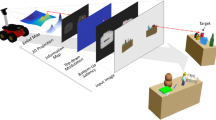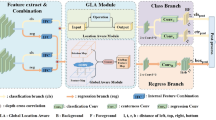Abstract
Inspired by human behaviors, a robot object tracking model is proposed on the basis of visual attention mechanism, which is fit for the theory of topological perception. The model integrates the image-driven, bottom-up attention and the object-driven, top-down attention, whereas the previous attention model has mostly focused on either the bottom-up or top-down attention. By the bottom-up component, the whole scene is segmented into the ground region and the salient regions. Guided by top-down strategy which is achieved by a topological graph, the object regions are separated from the salient regions. The salient regions except the object regions are the barrier regions. In order to estimate the model, a mobile robot platform is developed, on which some experiments are implemented. The experimental results indicate that processing an image with a resolution of 752 × 480 pixels takes less than 200ms and the object regions are unabridged. The analysis obtained by comparing the proposed model with the existing model demonstrates that the proposed model has some advantages in robot object tracking in terms of speed and efficiency.
Similar content being viewed by others
References
A. De Cabrol, T. Garcia, P. Bonnin, M. Chetto. A concept of dynamically reconfigurable real-time vision system for autonomous mobile robotics. International Journal of Automation and Computing, vol. 5, no. 2, pp. 174–184, 2008.
Z. H. Jiang. Vision-based Cartesian space motion control for flexible robotic manipulators. International Journal of Modelling, Identification and Control, vol. 4, no. 4, pp. 406–414, 2008.
J. D. Liu, H. Hu. Biologically inspired behaviour design for autonomous robotic fish. International Journal of Automation and Computing, vol. 3, no. 4, pp. 336–347, 2006.
G. V. Lauder, E. J. Anderson, J. Tangorra, P. G. A. Madden. Fish biorobotics: Kinematics and hydrodynamics of self-propulsion. Journal of Experimental Biology, vol. 210, no. 16, pp. 2767–2780, 2007.
T. J. Hu, L. C. Shen, L. X. Lin, H. J. Xu. Biological inspirations, kinematics modeling, mechanism design and experiments on an undulating robotic fin inspired by Gymnarchus niloticus. Mechanism and Machine Theory, vol. 44, no. 3, pp. 633–645, 2009.
L. Itti, C. Koch. A comparison of feature combination strategies for saliency-based visual attention systems. In Proceedings of SPIE Human Vision and Electronic Imaging IV, San Jose, California, USA, pp. 473–482, 1999.
L. Itti. Models of Bottom-up and Top-down Visual Attention, Ph. D. dissertation, California Institute of Technology, USA, 2000.
L. Itti, C. Koch. Feature combination strategies for saliency-based visual attention systems. Journal of Electronic Imaging, vol. 10, no. 1, pp. 161–169, 2001.
L. Itti, C. Koch, E. Niebur. A model of saliency-based visual attention for rapid scene analysis. IEEE Transactions on Pattern Analysis and Machine Intelligence, vol. 20, no. 11, pp. 1254–1259, 1998.
D. Walther, U. Rutishauser, C. Koch, P. Perona. Selective visual attention enables learning and recognition of multiple objects in cluttered scenes. Computer Vision and Image Understanding, vol. 100, no. 1–2, pp. 41–63, 2005.
P. Zhang, R. S. Wang. Hierarchical data competition in the bottom-up visual attention system. Journal of Computeraided Design and Computer Graphics. vol. 17, no. 8, pp. 1667–1672, 2005. (in Chinese)
M. Z. Aziz, B. Mertsching, M. Salah, E. N. Shafik, R. Stemmer. Evaluation of visual attention models for robots. In Proceedings of the 4th IEEE International Conference on Computer Vision Systems, IEEE, Manhattan, USA, pp. 20–25, 2006.
L. Chen, S. W. Zhang, M. V. Srinivasan. Global perception in small brain: Topological pattern recognition in honeybees. In Proceedings of the National Academy of Sciences of the United States of America, vol. 100, no. 11, pp. 6884–6889, 2003.
D. Walther, C. Koch. Modeling attention to salient protoobjects. Neural Networks, vol. 19, no. 9, pp. 1395–1407, 2006.
D. Walther. Saliency Toolbox, [Online], Available: http://www.saliencytoolbox.net/, December 20, 2008.
I. C. B. Goodhew, B. D. Hutt, K. Warwick. Control and experimentation of a personal robot tracking system. International Journal of Modelling, Identification and Control, vol. 1, no. 1, pp. 4–12, 2006.
P. Yang, W. Y. Wu, M. Moniri, C. C. Chibelushi. A sensorbased SLAM algorithm for camera tracking in virtual studio. International Journal of Automation and Computing, vol. 5, no. 2, pp. 152–162, 2008.
D. Xu, M. Tan, X. G. Zhao, Z. G. Tu. Seam tracking and visual control for robotic arc welding based on structured light stereovision. International Journal of Automation and Computing, vol. 1, no. 1, pp. 63–82, 2004.
S. Wang, H. Z. Ai, K. Z. He. Difference image based multiple motion targets detection and tracking. Journal of Image and Graphics, vol. 4(A), no. 6, pp. 470–475, 1999. (in Chinese)
L. S. Wang, Y. H. Cheng. An improved background subtraction using adaptive Gaussian mixture models. Journal of Northern Jiaotong University, vol. 27, no. 6, pp. 22–25, 2003. (in Chinese)
S. J. Sun, D. Haynor, Y. M. Kim. Motion estimation based on optical flow with adaptive gradients. In Proceedings of the International Conference on Image Processing, IEEE, Vancouver, BC, Canada, pp. 852–855, 2000.
P. J. Burt, E. H. Adelson. The Laplacian pyramid as a compact image code. IEEE Transactions on Communications, vol. 31, no. 4, pp. 532–540, 1983.
B. M. H. Romeny. Front-end Vision and Multiscale Image Analysis, Netherlands: Kluwer Academic Publisher, 2003.
K. Fukunaga, L. D. Hostetler. The estimation of the gradient of a density function, with applications in pattern recognition. IEEE Transactions on Information Theory, vol. 21, no. 1, pp. 32–40, 1975.
D. Comaniciu, P. Meer. Mean shift: A robust approach toward feature space analysis. IEEE Transactions on Pattern Analysis and Machine Intelligence, vol. 24, no. 5, pp. 603–619, 2002.
R. H. Li, J. K. Chu, C. L. Xu, Q. Y. Li. Design and realization of intelligent mobile robot platform for micro navigation sensors. Transducer and Micro System Technologies, vol. 27, no. 10, pp. 118–120, 2008. (in Chinese)
C. Zhao, X. H. Shang, S. Q. Geng. Control system for micro soccer robot. Journal of Harbin Institute of Technology, vol. 35, no. 9, pp. 1033–1035, 2003. (in Chinese)
D. Walther, U. Rutishauser, C. Koch, P. Perona. On the usefulness of attention for object recognition. In Proceedings of Workshop on Attention and Performance in Computational Vision at Europeon Conference on Computer Vision, Czech Republic, pp. 96–103, 2004.
D. Walther, L. Itti, M. Riesenhuber, T. Poggio, C. Koch. Attentional selection for object recognition — a gentle way. Lecture Notes in Computer Science, Springer, vol. 2525, pp. 251–267, 2002.
Author information
Authors and Affiliations
Corresponding author
Additional information
This work was supported by National Basic Research Program of China (973 Program) (No. 2006CB300407) and National Natural Science Foundation of China (No. 50775017).
Jin-Kui Chu graduated from Hangzhou Dianzi University (HDU), PRC in 1986. He received the M. Sc. degree from Xian University of Technology (XAUT), PRC in 1989, and the Ph.D. degree from Beijing University of Aeronautics and Astronautics (BUAA), PRC in 1992. He is currently a professor at School of Mechanical Engineering in Dalian University of Technology (DLUT), PRC.
His research interests include intelligent robot, biomimetic sensor, micro-actuator, and electronic measurement techniques.
Rong-Hua Li graduated from Dalian Jiaotong University (DJTU), PRC in 2005. He is currently a Ph. D. candidate at School of Mechanical Engineering in Dalian University of Technology (DLUT).
His research interests include robot vision and intelligent control.
Qing-Ying Li graduated from Zhejiang University of Technology (ZJUT), PRC in 2006. He received the M. Sc. degree from Dalian University of Technology (DLUT), PRC in 2008. He is currently working in CSR Sifang Locomotive and Rolling Stock Co. Ltd.
His research interest includes robot vision.
Hong-Qing Wang graduated from Dalian University of Technology (DLUT), PRC in 2007. He is a master student at School of Mechanical Engineering in Dalian University of Technology (DLUT).
His research interests include intelligent control of mobile robot.
Rights and permissions
About this article
Cite this article
Chu, JK., Li, RH., Li, QY. et al. A visual attention model for robot object tracking. Int. J. Autom. Comput. 7, 39–46 (2010). https://doi.org/10.1007/s11633-010-0039-1
Received:
Revised:
Published:
Issue Date:
DOI: https://doi.org/10.1007/s11633-010-0039-1




